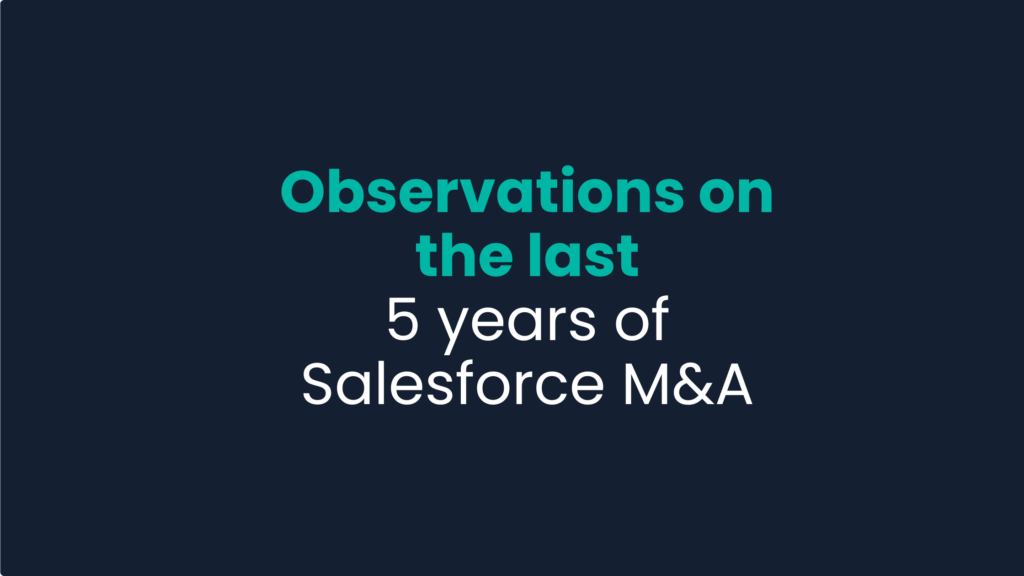When I talk with founders about who they want as an acquirer, Salesforce is far and away the most common name. A big part of this is because Salesforce covers so much ground: software for sales, service, commerce, marketing, data and more. Almost any company could be purchased by Salesforce. With that kind of coverage — and market leadership in many of the categories— it’s no wonder why smaller SaaS businesses would love to join. Being acquired by Salesforce would mean getting your product in the hands of thousands of new customers.
This is not a farfetched idea, either. Salesforce has been an active acquirer, especially in the last decade. Some of the flashiest SaaS acquisitions have been Salesforce acquisitions. They’ve also expanded beyond just acquisition and have enough activity that they have separate internal teams for M&A, integrations and venture capital.
For this article, I looked at every acquisition Salesforce has completed since 2019 (the last five years) and tried to pull out a few trends based on the data.
Of course, Salesforce has been buying companies for a lot longer than the past five years (many of which have been a core part of their growth strategy). Some of the notable ones that I won’t be covering are Quip, MuleSoft, DemandWare, ExactTarget and several others. This doesn’t cover venture capital and minority investment activity, and I also removed the Neiman Marcus deal from this summer. The focus of this article, however, isn’t a historical strategy analysis. It’s an attempt to make sense of their recent activity.
Here’s what I learned.
Salesforce has made 24 acquisitions since 2019. From 2019 to 2022, the volume of acquisitions was fairly evenly distributed (the highest year being 2021 with seven closed deals). In 2023, there were zero acquisitions and there have only been two in 2024. This is certainly lower than earlier years but the 2024 activity is also perhaps a sign that M&A is starting to show signs of life once again.
The median deal size was $340m. Of the 24 acquisitions, 13 had public deal values. I highlighted the median because the largest deals (Slack, $27.1b and Tableau, $14.8b) pulled up the average quite a bit ($3.6b). There were four deals over $1b in size, five that were between $100m and $1b, and four that were under $100m.
63% of the acquisitions (15) were of companies that had raised venture capital. Depending on your perception of Salesforce, this is probably either a lot higher or a lot lower than you might expect. VC-backed companies are often touted for their innovation. They are more likely to be purchased for strategic decisions: add a highly talented team who can (or has) built a product that’s on the roadmap already. This shows up with many Salesforce acquisitions, from Tableau being a core component of their data play (raised $175m) to smaller ones like Mobify, a headless commerce platform that they purchased in late 2020 (raised $22m). But Salesforce has also purchased plenty of bootstrapped companies—also for seemingly-strategic reasons.
Salesforce Ventures had previously invested in 6 of the 24 acquisitions (25%). I’ve read a few articles that claim that Salesforce uses their venture arm as a pipeline for their M&A activities. This seems to be partly true: Salesforce Ventures no doubt provides an extension of the M&A pipeline. But the majority of Salesforce’s M&A activity comes from things that they didn’t previously invest in. This is even more pronounced by deal size as Salesforce didn’t previously invest in either Slack or Tableau (which represent ~90% of disclosed deal value). Note: an interesting follow-up analysis might be analyzing the acquirers for Salesforce Ventures-backed companies (the “other side” of this article). If interested, let me know.
The average and median age of the target at acquisition was 10 years. This should come as no surprise. Not only do VCs often cite 7-10 years as the time from founding to exiting, but it passes the gut check as an average age of a software business at exit. The youngest company they bought was Bonobo AI, an AI analytics tool that Salesforce purchased in 2019 just two years after it was founded. The oldest target company was Atonit: 23 years old when they were bought in 2022.
79% of the targets were based in North America. Outside of North America, there were three in Western Europe, one in South America and one in Israel. As you would expect, the area with the highest density of target HQs was the Bay Area (5).
88% of the acquisitions were software companies. 21 of 24 deals were software, two were services, and one was community (The CMO Club, since spun back out). Salesforce’s acquisition activity has heavily centered around software, and I’d expect that to continue. (This is, perhaps, obvious as Salesforce is a software company!).
The two professional services acquisitions Salesforce closed share some similar characteristics. The two services deals were Acumen Solutions ($430m, 2021) and Traction on Demand ($340m, 2022). They shared a few similar characteristics (borrowing some insights from Chris at Tercera, 1, 2). First, they were very large services acquisitions. This is essential for Salesforce, a company with over $30b in revenue — buying one large consultancy is much easier than a bunch of small ones. Second, they both were very tightly focused on the Salesforce ecosystem (along with close partners to Salesforce). This makes the M&A narrative a lot easier than a consultancy split across several different software vendors. Finally, each of them seemed to have a customer base or talent pool with strategic value (Acumen with key public sector customers and Traction on Demand with skilled talent in Canada and India). For Salesforce to keep services the same percentage of their overall revenue (around 5-6%) they need to hire lots of people or buy large consultancies, which likely was a big reason for both of these deals.

